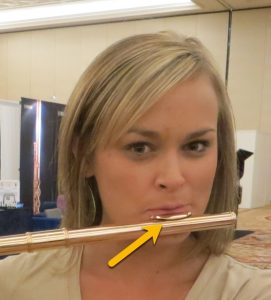Sometimes it can be difficult creating the perfect tone for low notes. Luckily, I have found a few tricks to help you learn how to fix low notes on the flute. With a little bit of practice you can have clear confident sounding notes that will enchant your audience and make you happier.
Many people say that their favorite sound from a flute are the low, beautiful tones. They are haunting and calm your mood immediately.
Assuming you are like most and need some help fixing your low notes on the flute, let’s dive into some tangible skills you can work on this month.
1. Flatten your aperture for low notes
The area where the air comes out of your mouth is called your aperture. This also includes the muscles that are used to create its shape.
Newer players usually have a really large sized aperture. It’s okay if this is you. You’ll gain more control as you learn and develop here.
Learning how to flatten your lips just a tiny bit more will make a big difference in the tone of your low notes.
2. Widen your throat
Think of yawning. When you yawn your throat gets super wide because it is trying to get as much air in as possible. This also will help your vocal chords not get involved. Relax those throat muscles to get a more resonant tone.. especially on those low notes.
There is a possibility of pulling the cheeks back in an effort to flatten the aperture.. this causes another issue that will have a domino effect and create other issues like sounding really flat.
The more space you have in your mouth the more clear and resonant your low notes will be.
3. Keeping your tongue down produces a low note
 What does our tongue have to do with playing low notes on the flute? A lot actually. Don’t let your tongue get in the way of your beautiful sound.
What does our tongue have to do with playing low notes on the flute? A lot actually. Don’t let your tongue get in the way of your beautiful sound.
After the initial tonguing at the beginning of the note, try dropping your tongue so it doesn’t interfere with your tone. Keeping the ends of your low notes open (instead of chopping them off with your tongue) is a nice way to ensure that they end well also. This gives a choppy ending to the amazing note you were trying to play.
Think of running past a bright, breathtaking rainbow only to find there was no pot of gold at the end. (Sad!) If you leave the end of your note open, it resonates so much better.
4. Keep from clenching your teeth
Our teeth also have something to do with our sound… especially on low notes and the very high ones. Thinking about what’s going on inside your mouth is a good way to start learning how to control what your notes sound like. Each range on the flute has a different personality.
The same rule will always apply in flute playing.. the more relaxed you can get your body, the better your sound will be.
It’s kind of hard advice to follow sometimes, but you can definitely do it with time and focused practice.
5. Don’t forget to be confident
Even if you’re not feeling as confident in your playing abilities, fake-it for now and keep trying to make it! Your tone will dramatically when you have faith that you’ll get there.. and you can continue to relax and focus on the good skills are you practicing.
If you need more help creating a nice, solid tone (including your low notes) check out this video where I show you an easy to follow recipe for great sound on the flute.
Following these few tricks with some focused practice will help your low notes sound bigger, better, and more resonant. You can do it!



